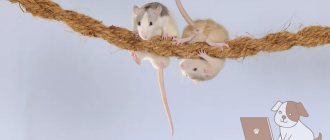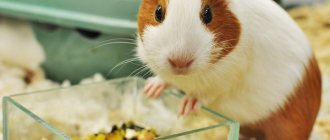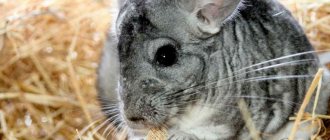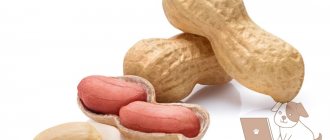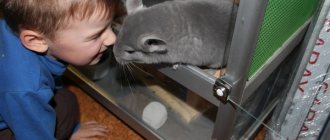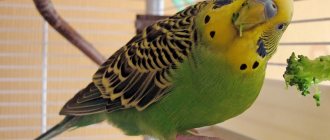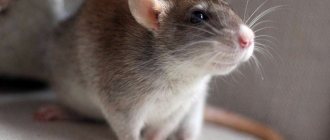Rules of communication
The chinchilla is a rather shy animal. The place to play must be safe. It is necessary to remove all unnecessary things so that the frightened animal does not get hurt when trying to hide. He can ruin his favorite item with his sharp teeth. When pulling your pet out of its cage, it may break free and fall. It is recommended to place a pillow or small mattress on the floor as insurance.
Playing with a chinchilla at home is extremely beneficial for the animal. In order for joint games to go smoothly, you need to learn how to hold a chinchilla in your arms correctly. Before removing the animal from the cage, it is recommended to wear gloves or use a sheet. This will help avoid animal bites. Handle the rodent carefully, using both palms. It must be in an upright position. The owner holds the front paws and tail. You cannot grab the animal by its fur. The pet will get scared and fall out of your hands.
When communicating with a rodent, you must adhere to the following recommendations:
- Do not put pressure on the animal. You cannot force an animal to leave the cage when the owner wants it. He must choose a time convenient for himself.
- Do not make noise or make sudden movements. It is difficult to establish contact with a pet. From fright, he will lose trust in his owner.
- There should be no foreign odors. Before picking up an animal, you need to wash your hands well with soap.
- The best time to play with a chinchilla is in the evening.
Product requirements
The question arises - do it yourself or buy it ready-made?
There are no big differences in the design of a human hammock and a chinchilla hammock. Both consist of elements that are securely attached to four points of support and are some distance from the ground level.
If the hammock is made of fabric, it must:
- be dense enough and not susceptible to rodent teeth;
- securely fixed to the roof/walls of the cage using carabiners or tied with such materials that a captive chinchilla cannot chew through them;
- have an environmentally friendly, safe and durable material base - it should not tear or stretch when an animal jumps on it (fleece, denim, cotton fabrics).
What toys do chinchillas like?
Today you can buy a large number of different toys in stores. However, the chinchilla itself must choose the appropriate specimen. To do this, the owner should find out the pet's preferences. This can be checked using a small ball. Some animals run after him if you push him. Others are indifferent to him. When buying a toy, you need to monitor the animal’s reaction. For chinchillas, toys are an integral part of a happy and long life.
Selection rules
Before giving your chinchillas any accessories, you need to know the rules and regulations for using these toys. First you need to understand what material the accessory is made of. Chinchillas are prohibited from giving toys made from:
- rubber;
- low-quality plastic;
- cement;
- lime;
- paper;
- cardboard;
- glass
Also, some types of wood are contraindicated for these pets.
There are some other selection rules that will have to be taken into account when purchasing.
- The chinchilla will be able to bite and swallow small objects.
- You should not purchase toys that have been painted, because the skin of the animal may rub against the paint, which can lead to poisoning. It is better to purchase accessories that have neutral tones or are completely colorless.
- It is forbidden to buy toys with sharp corners and jagged edges, because the chinchilla may get hurt.
Moving toys
Movable toys help your pet stay in shape. Chinchillas love hanging structures. They stagger, rattle and ring. The animal can swing them in different directions. With the help of them he can grind down his teeth. Rodents prefer to play at night, so moving toys have a downside. Not every owner is ready to tolerate loud noises at night. Therefore, they must be removed so that the pet plays only during the day.
walking ball
With the help of such an item, the animal will be able to walk around the apartment without fear of being crushed. Thanks to this, furniture and wires will remain safe: the animal will not be able to reach them. Durable transparent plastic is used as the material for the ball. It must have holes for ventilation. The design consists of two hemispheres that unwind or close. Before purchasing, you should pay attention to the disadvantages of the toy. Small holes do not provide proper ventilation of the air inside the ball. Leaving your pet for a long time can lead to suffocation. You should not leave the animal in such a toy unattended.
Hanging toys
When they first appeared, hanging toys were used for birds. Over time, they began to be offered to rodents. Animals like shaking structures that make a ringing sound. Excessive noise is the main disadvantage of such toys. So that the pet and the owner can take a break from the ringing, it is necessary to remove the hanging object from the cage at night.
Spinning wheel
The wheel is very popular among rodents. A chinchilla can run for several hours, skipping sleep time. Wood, metal, plastic and aluminum are used to make wheels. A metal product is considered the most durable and durable. However, there are dangers when using it:
- When keeping several animals in one cage, the metal wheel stand can pose a danger to them. While one animal runs, another can seriously damage its paws.
- Your pet may get a claw or fur caught in the mesh used as a wheel cover.
To ensure safety, the exercise machine is covered with thick fabric. The plastic version does not have a stand, so it is less dangerous. The wheel is attached to the wall of the cage. The maximum diameter size is 32 cm. It is not suitable for many animals. Therefore, it is better to buy a wooden or aluminum wheel. Their diameters are much larger and can reach up to 40 cm. A wooden product cannot be bought at a regular pet store. It can be made to order, or made by yourself. The aluminum trainer is not so popular due to its high cost. It is due to delivery from abroad.
Making a spinning wheel at home
To make a rotating wheel with your own hands, you will have to put in a lot of effort. Proficiency in wood or metal cutting will be a plus.
Materials and tools needed for the wheel:
- a tool for cutting metal, for example, a grinder;
- fine-grained sandpaper;
- aluminum pan - diameter not less than 40 cm;
- nut and bolt.
After purchasing all the necessary items, we begin making the simulator:
- The first step is to saw off the excess edge of the pan. Its height should be about 15 cm. To avoid injury to the pet, the edges are sanded with sandpaper. A hole is drilled in the center of the bottom of the pan.
- The future product is placed inside the cage. Using a bolt, the workpiece is attached to the rods. From the outside, you need to tighten the nut so that the wheel rotates freely.
A homemade exercise machine is much safer than a purchased one. The finished product should be checked for functionality. If the wheel does not spin, the nut must be loosened.
Wheels
A wheel that can rotate is a good exercise machine for a chinchilla, which also serves as entertainment for it. It is produced in several versions:
- made of plastic (not very durable, but quite safe, up to 32 cm);
- made of wood (high-quality environmentally friendly material, but such wheels for chinchillas are made only to order);
- made of metal (durable, but unsafe: the animal can be injured while running or get stuck in the mesh covering the wheel).
Instead of a fine mesh, it is better to cover a metal wheel for a chinchilla with thick cotton (old jeans).
Static toys
Static toys are more like a piece of furniture for a chinchilla’s home. However, they help your pet lead an active lifestyle.
Shelves
For rodents, shelves are considered an ideal play option. Animals need regular exercise on their paws. So that the pet can easily jump onto the shelf, it is fixed at a height of 70-80 cm. If the animal falls from such a height, it will not be injured. You can make wood products yourself. They are good for grinding down claws and teeth.
Tunnels
Chinchilla tunnels are pipes of different diameters. In a cage with a large number of animals, they are an integral part. Animals can run after each other and hide. To prevent the pet from getting stuck, the tunnel is made with a diameter of 40 cm. Wood and plastic are used as materials. The wooden product has a metal edging. It protects the edges from the animal's teeth. There are many options for plastic tunnels. From a large quantity you can assemble a tunnel of a certain type. The best solution is a product made of translucent plastic. The chinchilla is comfortable and safe in it, and the owner can easily find the pet.
Sticks and ladders
Ordinary sticks cause great delight in the rodent. He can roll them and chew them. When placing an object between the shelf and the floor of the cage, the pet uses the stick as a ladder. You can buy a special ladder that performs the same functions as a stick. Often the animal rubs its back against it. For convenience, the product is attached to the cage wall in a vertical position.
Hammocks
If a small cage is used as a home for a rodent, a hammock is a good solution. It can be hung by the bars of the lid and used as a place for the animal to rest and sleep. A hammock helps save space for games. There are several types of hammocks: rope, wooden and plastic. They can also be single-tiered or multi-tiered. The animal can use the hammock as a place to play hide and seek.
Sewing a hammock at home
You can make a hammock for a chinchilla yourself. To do this, you need to prepare the following items:
- ruler or measuring tape;
- needle and thread;
- glue gun and scissors, chalk;
- felt sheet and edging material.
Step-by-step instructions for making a hammock with your own hands;
- Rectangles measuring 20x25 cm are cut out of a sheet of felt. Using needles, they are attached to each other and excess fabric is cut off. For marking use white chalk or soap. Draw an oval outline at a distance of 2 cm from the edges, then cut it out.
- The tape for edging is cut into four equal sections 10 cm long. Then they are folded in half, gluing the fold. Using a glue gun, attach the tape to the corners of one piece of felt. It is necessary to maintain a distance of 3 cm from the edge.
- Another piece is applied to this piece and sewn together with a needle and thread. To make the hammock voluminous and cozy, you can add cotton wool or padding polyester between the fabrics.
- Before attaching the finished product to the cage, you need to choose a suitable location. Ribbons are used as fastening.
At first, the animal may ignore the hammock. When the pet gets used to it, he will be happy to climb there. Perhaps the very next day the animal will use the new object as a place to rest.
Soft, cute, gnawing: who is it?
Chinchillas are cute rodent pets famous for their warm, dense fur and adorable faces. They are bought by those who want to make their home more comfortable, because these animals are so cute! But we must not forget that this furry creature also needs comfort and coziness. Therefore, you can make a cute house for a chinchilla in which the animal will feel safe.
Chinchillas are crepuscular animals, so a cage house will be very useful so that your pet can hide there during the daytime and take a good nap. A home for a chinchilla is as necessary as a bed for a person, so don’t skimp on such important little things.
Toys from scrap materials
If the owner has enough free time, you can make toys for chinchillas with your own hands from available materials. The animal does not always pay attention to purchased products. Simple objects that can be chewed or rolled on the floor are often used as toys:
- A thread spool is a small item that is ideal for grinding down teeth and providing leisure activities for an animal.
- Walnut - the roar made when rolling this ball delights rodents. You can also use plastic, wood or foam balls instead.
- A piece of rope with knots at the ends - such a product can be dangerous for a pet. If an animal swallows a piece of thread, it will negatively affect the functioning of the stomach. Therefore, the rope piece is given with caution.
Benefits of soft carriers
A carrying bag allows you to protect your pet from outside influences.
We invite you to read: Herpes in cats: symptoms of the virus, treatment of infection, myth about the ability to be transmitted to humans
The animal will feel protected and experience less stress.
The fabric container is lightweight.
It is easy to store and does not burden the owner when transporting the pet.
Fabric carriers are elegant. Some varieties are no different from the usual bags.
For a fashionista traveling with a pet, a container can complement her look.
The carriers are made of material that easily allows air to pass through.
The pet will not lack oxygen or suffer from heat.
A properly selected container will not only make your trip easier, but will also guarantee comfort throughout the journey.
Unlike hard plastic baskets or metal cages, the animal feels more protected in a soft, cozy house. There is always an opportunity to hide from prying eyes, to hide from danger. This type of carrier takes up less space than a rectangular plastic box. In addition, through the flexible walls you can stroke and calm a pet frightened by an unfamiliar place, which may react inappropriately to a hand inserted inside, scratching the owner.
Self-tailoring provides ample opportunities for flights of fancy when decorating. All kinds of fabrics of original colors, beads, ribbons, buttons, braid, and other decorations are suitable for this. The bag can be made in the form of a familiar ladies' accessory. If the owner sewed such a carrier herself, she has the opportunity not to part with her pet even in those places where pets are usually closed.
Since making a mobile house for a pet is not particularly difficult for those who know how to operate a sewing machine, you can create a whole collection of designer attributes for different occasions: a light bag for the warm season, an insulated one for the winter, an elegant one for a trip to the guests, extravagant - for visiting tailed animals exhibitions.
In addition, an original portable bag for a cat, handmade and lovingly sewn to its individual dimensions, will be an excellent gift for a lover of these wayward pets.
Let's take a step-by-step look at sewing a carrier bag for a small cat or kittens.
Such a bag can be sewn, for example, from an old raincoat. In this example, the bottom and top are stitched. It is recommended to use fabric that is not very thick so that it can be sewn on a sewing machine. The bag consists of the following parts:
- the upper part is a rectangular piece measuring 32*55 cm,
- the bottom of the bag is a rectangular piece measuring 32*20.5 cm,
- two sidewalls,
- pens.
Dimensions are shown without seam allowances.
Beginning of work
Let's make patterns for the main parts of the bag on paper and cut out the parts from fabric.
When the main work of making the bag is completed, you can begin decorating.
Rhinestones, beads, threads, seed beads, applique, and fur are used for decoration. Decoration depends on the tastes of the housewife, the decorations at hand and imagination.
The following types of bead decoration are distinguished:
- Embroidery. This method is used primarily for decorating fabric accessories (silk, denim, cotton). In addition to beads, you can use rhinestones, coins, and ribbons.
- Pasting. It is suitable for leather, plastic, oilcloth and suede bags. Only use clear quick-fix adhesive. You will also need tweezers and a clean cloth to remove excess composition. After registration, the decor should completely stick together, this will take about two days.
The bag can be decorated with bead appliqué. The future decoration is woven separately and then simply glued or sewn to the bag. You can use this method if you plan to create a small beautiful accent on the bag in the form of a flower or a funny character.
Accessories
Transporting pets is a necessity often associated with visits to the veterinarian or relocation. To safely deliver your pet, a wide variety of carriers are available for sale, the cost of which can vary significantly.
Carrying
An important accessory, especially if you like to travel and plan to take your pet with you. For transporting your baby, carriers made of opaque plastic are best suited. They are lightweight, easy to clean, resistant to the absorption of foreign odors, and will protect the rodent from drafts. The size should not be less than 15x20x20 cm.
Leashes and harnesses
A harness is the best option for safe and convenient walking of small rodents. The harness is firmly fixed on the animal's body; the length adjusters allow you to adjust the length of the harness to the desired size. A leash is also firmly attached to it in order to become familiar with the outside world.
Methods and methods of taming
Young animal
Little chinchillas, once in the house of a new owner, behave very timidly. For this reason, you should not immediately pick them up. The animal is naturally curious and very soon it will want to communicate.
In order for a chinchilla to get used to a person, you need to talk to it more often. At the same time, the intonation of the voice should be calm. Try to stay near the cage more often so that the animal sees you and gradually gets used to it.
To tame a young chinchilla, you need to follow a certain algorithm:
- At first, you need to approach your pet’s cage slowly so as not to scare it. Try not to make sudden movements or make noise.
- You need to talk to your pet in a gentle, quiet voice. You should not bring your face too close to the animal, much less extend your arms towards it.
- When the chinchilla stops hiding from you, you can try opening the vivarium door. All movements must be done smoothly and unhurriedly, without any sharp sounds.
- After four days, try treating your baby with a tasty treat. Treats should only be given with an open palm. Animals begin to take food from the owner’s hands within one to two weeks.
- After this, carefully try to pick up the chinchilla. No need to grab her by the scruff of the neck. The animal will regard such actions as an attack by a snake and may bite the owner, while girls are capable of spraying a stream of urine.
When the pet gets used to the new place, gets used to the smells and the owner, you can take him in your arms, where he will play with pleasure.
When outside their home, chinchillas look in different directions to assess the situation and make sure there is no danger.
After some time, the animal gets used to the sound, hearing it, runs towards the meeting in anticipation of games and treats.
Young rodents quickly get used to their new owner. The main thing is to be patient. There is no need to rush things or forcefully take the animal into your arms. Such actions will only cause mistrust and frighten the animal.
How to teach an adult
There are very frequent cases when inexperienced people buy an already matured animal. The taming period depends on the following points:
- what living conditions did the rodent have before?
- whether he had experience interacting with a person;
- whether the animal is scared or not.
Of course, the process of taming will go faster when the animal has grown up surrounded by people since childhood. But it is also possible to tame a wild animal, the main thing is to be patient.
Chinchillas very rarely shy away from communicating with humans; in general, animals are willing to make contact, provided the correct approach to taming is used. With an adult pet, this process can take a long time.
In order for your chinchilla to quickly get used to its new owner, you need to:
- For the first few days, you should not disturb your pet. Let him get used to the new place, get used to the surroundings and smells.
- You need to put a special house in the cage in which the animal could hide.
- During evening games, chinchillas need to sit down next to the cage and talk to the animal in a quiet, calm voice. If the baby is not afraid, then you can proceed to the next step.
- Try hand-feeding your pet a treat, and be sure to talk to him. After some time, the animal will begin to climb into your arms.
- If the animal already had a nickname when you purchased it, you should not change it with a new one. A chinchilla, trained to respond to its name, will make contact faster.
The time it takes to accustom your pet to being held will depend on whether it has had contact with a person before. If not, then the pet will be shy and most likely constantly hide in the house. When a person tries to reach out to the chinchilla, the animal may bite.
To find an approach to such a pet, you need to give it time to adapt to new conditions. Only after this, gradually accustom the animal to the presence of the owner.
If the previous owner paid a lot of attention to the chinchilla, then gaining the animal’s trust will be much easier. The animal will quickly understand that it is not in danger and will begin to take the treat from your hands.
Adviсe
Every loving owner wants his pet to have only high-quality and safe toys and household items. Everything you need today can be purchased at a pet store. But some owners prefer home-made accessories to factory accessories. This way you can avoid low-quality materials getting into the cage, which can cause poisoning of the animal.
Important! Nothing can replace a chinchilla’s “live communication” with you; you need to communicate and play with them more!
The process of making a display house for fluffy and charming chinchillas
You need to take wooden panels and cut out of them using an electric saw or manually panels measuring 1200 mm by 800. Then everything is simple - to the top and bottom of a wooden panel measuring 1200 mm we nail smaller ones of 800. Between them at the edges we add wooden posts that can either nail to the panels, or simply glue. Nowadays, it is increasingly possible to find a method of gluing parts together, rather than using good old nails.
Modern adhesives connect wood and metal much more firmly, even than welding and nails. So we live in a time of revolutionary change, when nails are simply becoming a thing of the past. Next, a galvanized mesh is nailed into the space between the posts, or you can use acrylic glass - it is extremely strong and does not break into fragments like regular quartz glass. If you use acrylic glass, you need to take care of the ventilation of the room.
In general, chinchillas are not famous for their pungent odor, their fur does not cause allergies, and the animal does not emit unpleasant odors. But when using a grille, all the odors from the display case will get into the apartment, and if you take care of creating special ventilation for the animal, then it is possible to get rid of the unpleasant smell from the chinchilla house once and for all. Acrylic glass is glued using glue, and the edges need to be treated with sealant so that air does not leak behind the glass and from behind it.
Fur care
But what is really needed is a good brush to care for the animal’s thick fur. They get used to using a comb gradually. Usually chinchillas like this procedure and do not express dissatisfaction. Regular brushing will help avoid many problems with skin and fur: dermatitis, fungal diseases, infection with skin parasites. Also, using a comb before the exhibition, you can give your pet a more neat appearance.
However, finding a special comb for a chinchilla in Russia is not so easy: the product is quite rare and expensive.
It differs from ordinary brushes for animals by thinner, sharper and more frequent teeth, which can be compared to needles from a sewing machine. This brush combs out the animal’s thick fur well. You have a better chance of purchasing a special comb if you go to a large nursery. Typically, large breeders bring specialized products from European farms or work directly with manufacturers of products specifically for chinchillas. If this is not possible or the price of the product is too high, you can choose a brush for a cat or dog with the longest and most frequent teeth.
Purchasing a charming long-eared rodent involves the need to purchase a “rich dowry.” To provide a full menu, the cages must contain a drinking bowl, feeder and hay for chinchillas. These devices will help provide pets with the necessary food that contains the necessary nutrients.
Making a simple wooden structure
Step-by-step steps for making a wooden structure measuring 35x25x25 cm without a bottom:
- Apply markings to the workpieces.
- Cut out the walls and roof with a hacksaw.
- Mark the entrance on the front wall and windows on the side walls.
- Cut out the entrance hole and windows along the outlined contours.
- Sand the edges of the resulting parts.
- Drill holes in the walls and roof for furniture dowels.
- Fasten the walls and roof.
- Disinfect the product with a cloth moistened with water and alcohol.
- After drying, place the product in the cage.
To extend the durability of the product, the edges of the house parts can be covered with metal plates. Branch food and hay should always be present in the cage.

